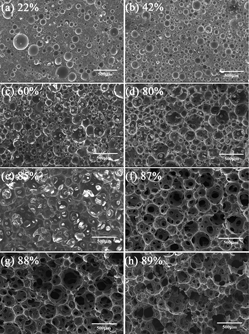Crossref Citations
This article has been cited by the following publications. This list is generated based on data provided by
Crossref.
SHU, Xia
LI, Jun
ZhANG, Hai-Long
DONG, Man-Jiang
SHUNZO, Shi-Mai
and
WANG, Shi-Wei
2013.
Gelcasting of Aluminum Nitride Using a Water-soluble Copolymer.
Journal of Inorganic Materials,
Yang, Yan
and
Wu, Yiquan
2014.
Tape-casted transparent alumina ceramic wafers.
Journal of Materials Research,
Vol. 29,
Issue. 19,
p.
2312.
Sun, Yi
Shimai, Shunzo
Peng, Xiang
Dong, Manjiang
Kamiya, Hidehiro
and
Wang, Shiwei
2014.
A method for gelcasting high-strength alumina ceramics with low shrinkage.
Journal of Materials Research,
Vol. 29,
Issue. 2,
p.
247.
Deng, X.
Wang, J.
Du, S.
Li, F.
Lu, L.
and
Zhang, H.
2014.
Fabrication of Porous Ceramics by Direct Foaming.
Interceram - International Ceramic Review,
Vol. 63,
Issue. 3,
p.
104.
Bai, Jie
Zhou, Anan
Huang, Zhifeng
Wu, Jifeng
Bai, Hua
and
Li, Lei
2015.
Ultra-light and elastic graphene foams with a hierarchical structure and a high oil absorption capacity.
Journal of Materials Chemistry A,
Vol. 3,
Issue. 45,
p.
22687.
Yang, Yan
Wei, Hua
Zhang, Lihua
Kisslinger, Kim
Melcher, Charles L.
and
Wu, Yiquan
2015.
Blue emission of Eu2+-doped translucent alumina.
Journal of Luminescence,
Vol. 168,
Issue. ,
p.
297.
Zhang, Peipei
Liu, Peng
Sun, Yi
Wang, Jun
Wang, Zhengjuan
Wang, Shiwei
and
Zhang, Jian
2015.
Aqueous gelcasting of the transparent MgAl2O4 spinel ceramics.
Journal of Alloys and Compounds,
Vol. 646,
Issue. ,
p.
833.
Deng, Xiangong
Wang, Junkai
Liu, Jianghao
Zhang, Haijun
Li, Faliang
Duan, Hongjuan
Lu, Lilin
Huang, Zhong
Zhao, Wanguo
and
Zhang, Shaowei
2015.
Preparation and characterization of porous mullite ceramics via foam-gelcasting.
Ceramics International,
Vol. 41,
Issue. 7,
p.
9009.
Yang, Zhigang
Yu, Jianbo
Li, Chuanjun
Zhong, Yunbo
Xuan, Weidong
Ren, Zhongming
Wang, Qiuliang
Dai, Yinming
and
Wang, Hui
2015.
Preparation of textured porous Al2O3 ceramics by slip casting in a strong magnetic field and its mechanical properties.
Crystal Research and Technology,
Vol. 50,
Issue. 8,
p.
645.
Yang, Yan
and
Wu, Yiquan
2015.
Environmentally benign processing of YAG transparent wafers.
Optical Materials,
Vol. 50,
Issue. ,
p.
32.
Li, Yong-gang
Wei, Ying-hui
Hou, Li-feng
Guo, Chun-li
and
Yang, Sheng-qiang
2015.
Fabrication and compressive behaviour of an aluminium foam composite.
Journal of Alloys and Compounds,
Vol. 649,
Issue. ,
p.
76.
Deng, Xiangong
Wang, Junkai
Huang, Zhong
Zhao, Wanguo
Li, Faliang
and
Zhang, Haijun
2015.
Research Progress in Preparation of Porous Ceramics.
Interceram - International Ceramic Review,
Vol. 64,
Issue. 3,
p.
100.
Yang, Yan
Liu, Yin
Shimai, Shunzo
and
Wu, Yiquan
2016.
Green and Sustainable Manufacturing of Advanced Material.
p.
497.
Deng, Xiangong
Wang, Junkai
Liu, Jianghao
Zhang, Haijun
Han, Lei
and
Zhang, Shaowei
2016.
Low cost foam-gelcasting preparation and characterization of porous magnesium aluminate spinel (MgAl2O4) ceramics.
Ceramics International,
Vol. 42,
Issue. 16,
p.
18215.
Yang, Zhigang
Yu, Jianbo
Ren, Zhongming
Li, Chuanjun
and
Deng, Kang
2016.
Fabrication and Characterization of Porous Alumina-Based Ceramics Using Silicone Resin as Binder.
Transactions of the Indian Ceramic Society,
Vol. 75,
Issue. 1,
p.
40.
Deng, X. G.
Wang, J. K.
Zhang, H. J.
Liu, J. H.
Zhao, W. G.
Huang, Z.
and
Zhang, S. W.
2016.
Effects of firing temperature on the microstructures and properties of porous mullite ceramics prepared by foam-gelcasting.
Advances in Applied Ceramics,
Vol. 115,
Issue. 4,
p.
204.
Levkov, R.
and
Kulkov, S.
2016.
Structure and properties of porous ceramics obtained from aluminum hydroxide.
Vol. 1760,
Issue. ,
p.
020042.
Sun, Yi
Peng, Xiang
Shimai, Shunzo
Zhou, Guohong
and
Wang, Shiwei
2016.
Improved Strength of Alumina Ceramic Gel and Green Body Based on Addition‐Esterification Reaction.
International Journal of Applied Ceramic Technology,
Vol. 13,
Issue. 6,
p.
1159.
Mehr, Mehrad
Davis, Calvin
Sadman, Kazi
Hooper, Ryan J.
Manuel, Michele V.
and
Nino, Juan C.
2016.
Epoxy interface method enables enhanced compressive testing of highly porous and brittle materials.
Ceramics International,
Vol. 42,
Issue. 1,
p.
1150.
Wang, Xiaofei
Xiang, Huimin
Wang, Guigen
and
Zhou, Yanchun
2016.
A green fabrication strategy for porous Yb3Al5O12 ceramics with high strength and tunable gas permeability.
Journal of Materials Research,
Vol. 31,
Issue. 19,
p.
3078.



